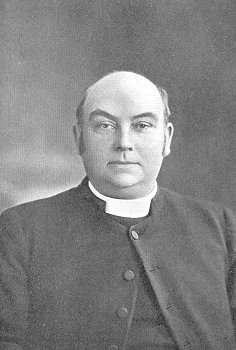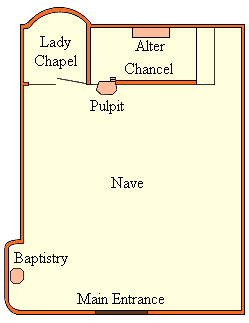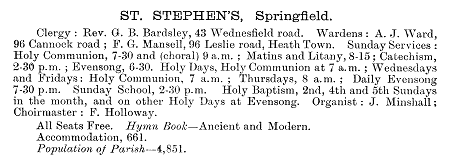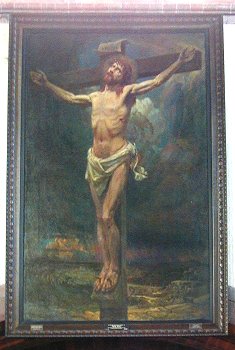|
The Early
Years at St. Stephen’s Church
The first vestry meeting took place
in 1909 with the Rev. Hugh Tunnadine in the chair.
During the meeting the church’s first two churchwardens
were appointed. They were Mr. F. Orme and Mr. J.
Woodward. The church also received a generous gift of
£500 towards the building deficit. |
|

The Rev. Hugh Tunnadine. |
In 1911 land was purchased from the
Earl of Darlington at a cost of £150 for a new vicarage,
but it would be some time before the building appeared.
In the meantime the clergy occupied a house at 43
Wednesfield Road, which belonged to the safe-maker Cyrus
Price. Unfortunately the house was unsatisfactory
because of its smoky chimney, outside toilet, and mice.
The first edition of the church’s
parish magazine appeared in January 1912 and the first
stained glass widows were installed in 1921 along the
east wall, as a memorial to the dead from World War One.
On 6th January, 1923
Hugh Tunnadine was succeeded by the Rev. George B.
Bardsley and soon afterwards the war memorial was
erected in front of the church.
|
| Later that year the St. Stephen’s Choral Society
gave its first concert. Productions over the next few
years included “The Victor’s Throne” a sacred cantata
performed at the church in 1925 and the “Advent of the
King” performed in December 1926. Music at the church
flourished with the formation of the Amateur Operatic
Society who performed their version of “The Gipsy Queen”
on 6th
April, 1926 at the day school. During Easter week, 1930
they performed Gilbert and Sullivan’s “HMS Pinafore”,
and gave another performance later in the year at Christ
Church parish hall. In the following years other Gilbert
and Sullivan works were performed including “The Pirates
of Penzance” in 1931 and 1937, “The Mikado” in 1932,
“Iolanthe” in 1933 and 1936, “The Yeoman of the Guard”
in 1934, and “The Gondoliers” in 1935.
The society gave its last performance in 1937. |

The Nave. |
|

The church as seen from Water
Street. |
In 1924 the Rev. Bardsley organised
a Sunday outing to Codsall for the children from the
school.
A party of 350 including staff and
friends travelled to the village on a special train, and
later enjoyed an excellent tea at the Reliable Stores.
|
|
The school received an inspection
by the Rev. Parkhouse in 1926. His report included the
following:
The excellent tone of the school
is well maintained. The children are thoroughly well
taught. They are bright, interested, and attentive.
Questions put to them revealed a good practical
knowledge of the bible, and thorough grasp of the use of
the sacraments. The children are taken to church
frequently. Additional prayer books are needed.
1926 also saw the setting-up of the
Additional Curate Fund to raise money for an assistant
priest. Miss Bardsley, the vicar’s sister became
secretary, and as a result of their fund raising, the
post was soon occupied by the Rev. W. J. Evans, a master
at Wolverhampton Grammar School.
|

A plan of the church. |

From the 1927 Wolverhampton Red Book.
|
At the time money was in short
supply. The Vicarage Fund trying to raise money for a
new vicarage, and the Playground Fund attempting to
raise money for an improved surface on the school
playground, were not having much success. Even so £60
was found as a down payment on a church organ, purchased
from organ builder, Mr. Hewins of Stratford on Avon.
|
|

George Phoenix's "Crucifixion". |
In 1933 the Rev. Bardsley left the church and was
succeeded by the Rev. William Hassall, whose sister Vera
became head of the day school. In 1936 they became the
first occupants of the finally completed vicarage, next
to the church in Hilton Street. Local Artist George
Phoenix died in 1935.
Two years later his trustees presented the church
with a fine Phoenix painting of the crucifixion, which
was hung on the north wall of the sanctuary, until its
move to the west wall in 1951.
|
|

The inscription below the
painting.
|
 |
|
 |
|
 |
Return to
the
3rd church |
|
Return to
the
beginning |
|
Proceed to
World War 2 |
|